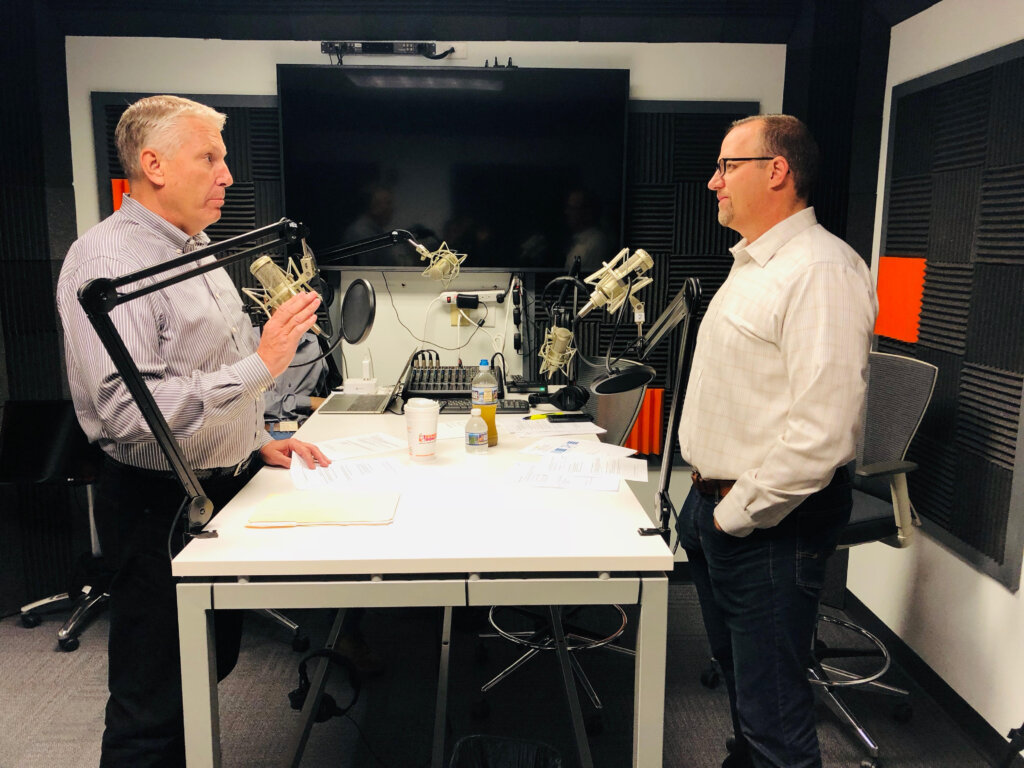Maxwell Executive Leadership Podcast #22: Exhibiting Empathy, EQ and Engagement

Everybody wants engagement. But, what many people don’t know is that the number one driver of engagement is empathy. In Episode #22 of our Executive Leadership Podcast, Perry Holley and Chris Goede will unpack empathy including how leaders can build empathy as a skill, the difference in empathy vs. sympathy and how empathy drives stronger connection and engagement.
Listen to all podcasts in this series and subscribe to new episodes on iTunes– or Google Play.
Read the transcript below:
Welcome to the John Maxwell Company Executive Leadership Podcast where our goal is to help you increase your level of influence, increase your reputation as a leader, and increase your ability to fully engage your team to drive remarkable results. Hi, I’m Perry Holley, a John Maxwell Company facilitator and coach and I’m Chris Goede, Vice President of The John Maxwell Company. Welcome and thank you for joining.
So, Chris, continuing our little mini series on sustaining engagement, I today wanted to talk really about exhibiting empathy. It’s an easy word to throw around. People talk about it. I’m not sure, I think it’s a skill, but we’ll see what you think. I know on the podcast in the past when it comes to engagement, we referenced a YouTube video that I like to drop on a board for people that who is sinking your boat. Bob Keller heard his team had posted that and the outcome of that, of those engagement studies, said about 30 percent of the people in your boat rowing with you, 50 percent of the people in the boat are sitting with the oar across their lap, watching the scenery go by. And 20 percent are actually trying to sink the boat and a little after that, Keller heard his team produce a second video about who still sinking your boat. And it was there that I saw that they claimed the number one driver of engagement. So, I’m thinking about a high engagement leader. The number one skill would be empathy. I was a little blown away by that I kept looking at that like that can’t be it. But what are your thoughts on that?
Well, it’s interesting, right? You talk about the word leader being such a strong word and then you’re going to try to tie the word empathy to a leader, right? We want to be a director, a driver. We want to be a decision maker. What’s interesting about this, when you look at the culture problem in corporate America and you look at the lack of engagement. You mentioned here in this illustration, it talking about the engagement level being at 30 percent. I think I saw a article just recently, somebody released it, and it said, yeah, yeah, no, no, no. It’s up to 32 percent. I’m like, okay, good. So it’s three point two of a person, right? But, here’s the thing, when you talk about the bottom line, you’re talking about the problem in corporate America and what it’s costing them and turnover and the hiring process and onboarding, lot’s of it is ultimately driven to engagement. So, I love that we’re spending a couple of sessions talking about this and so really, let’s talk about that. We’re really talking about EQ. The buzzword out there these days is really around EQ. What EQ is, it’s a complex world and we could unpack it for probably a day and what that looks like when it comes to leading people. But today specifically, let’s just unpack this word empathy and I think it’s a great place to start.
You know, for us to be able to empathize with people, the first thing we have to do is be able to relate to them, which allows us to connect to them, which will then allow us to ultimately be empathetic with them. We talk a lot about different ways to connect with people. At Level 2, people follow you because they want to. His key word there is a relationships, I like to use the word connect more than relationships because let’s just be honest, not everybody wants to build a relationship with the people that you work with or you lead or you have influence with. Matter of fact, if you’re listening right now, you’re probably thinking about two or three of those people that you wish you didn’t even have a relationship with, right? We are people so that is true. So, John talks about in the 5 Levels, we have to be able to connect with them and he wrote a book and it’s funny, John’s a great communicator, you know, when we talk about what is the one thing that you and only you can do for your organization. When we look at John for our organization, there’s probably many things, but specifically for us, it’s content, writing these books and communicating.
So it’s two things for sure. And he says in his book, well, the easiest book he ever wrote for him was the book called Everyone Communicates, Few Connect. It’s just what he’s been blessed with and he’s able to do it. And so it’s interesting because in there he unpacks different ways for us to relate to our people or those we have influence with and when you relate to them, as I mentioned a minute ago, you connect and you’re able to show empathy through that, and you’ll increase your influence. At the end of the day, connecting is all about other people and I think part of the problem with some leaders out there and even in myself and yourself, at times we get selfish and when we make it about ourselves, we don’t have the ability to empathize with our team members. And so we have to have that. The first mindset around empathy it has to be all about them. So that’s a little more than you asked for. But some of the things I was thinking about.
That’s all great. And I’m thinking through, you know, when the pressure’s on, it’s really when I start looking internally and they thought and that’s what the great part of the skill is. I recall my son struggling with at work and he asked me, that was kind of an off the wall question. Hey, why do people get so angry? I said, do you have anything going on in your life right now that’s troubling you? Challenges you’re facing? He said yeah. I said, so do they. And it just reminded me and the Keller video actually calls this out, is that you’re not just trying to engage the employee part of the person. You actually, you get the whole person when they come to work. We don’t look at that. I look at them that, oh, that’s the John Maxwell Company person, or they’re the x company person. No, you have the whole person. And that’s where the work life, personal life, they can’t just leave that at home. How do you see that when you’re thinking about engaging people and showing empathy?
If we’re going to ask people to be authentic and we’ve talked about this in some previous sessions together. It’s the number one attribute for leaders to have and we can’t ask them to be somebody different at work than they’re at home and vice versa. Right? And, so with that, we have to understand that and we’ve have to go after helping them develop both personally and professionally. We, at the John Maxwell Company, we do something that is a little different, which that’s not surprising. We try to kind of live out the principles of John’s leadership and what we do for organizations around the world. We are people. We don’t do it really well. If you had another couple of hours you want to listen to this podcast, we could begin to unpack that and, and I’d lay down on the couch and I’d pay you for the session, but we do this a thing with our team members called your personal, your professional, your financial goals. And when I talk about it, whenever I’m speaking or with clients, they’re like, really? Like, you’re going to talk about what their personal goals are and even financially and I look at him, I go, I know it’s crazy. I was like, do you know I spend more time with the people that I work with and I do my own family? They’re like, I do, too! I’m like, okay, well why would I not want them to be the best that they can be? And so you have to understand that there’s a personal element to this for you to be able to connect with your people. It’s really just understanding what’s going on and what do they want to achieve and what are they falling short of and have those conversations that allows you to connect with them, personally.
And, so I mentioned earlier that I hadn’t really thought about it until I started diving into this in my own personal leadership journey, but empathy is a skill. I believe you probably have some others that you could always use more of it and I believe it is developed with some intentional effort. What have you seen and especially maybe in the 5 Levels how we look at doing that?
Well, you are spot on. John actually says in one of the chapters, everyone communicates, few connect. I think that the subtitle is, is exactly that. It is a skill, not necessarily a talent, and it just doesn’t happen by accident. So you know, another big word we talk about around here is the intentionality. And so you have to be intentional about developing that. Now for some of us, the skill is going to come easier than others. And if you identify yourself on the 5 Levels influence scale as more of the permission level, the people follow you because they want to because you easily build relationships and you connect, it’s going to be a little bit easier. But you’re still going to have to develop that skill. Those that are on the task side, the production side to the natural level three bent, it’s going to be a little bit harder for you and you’re going to have to develop some learned behaviors and maybe even a little bit of structure and guard rail because you probably don’t naturally want to go and develop a skill that allows you to be empathetic with your people because you don’t have time for that.You just want to get things done.
Sure. And what I’ve noticed on the other side is I’m a relationship guy. I think we’ve already covered that ground here, but. Well, one of the challenges I find that I’m, I’m by nature, highly empathetic, but I slip into a problem. I noticed this first in my marriage and then second and my coaching and third in my work that I want to solve your problem. Can I just fix it? Just tell me, open up to me and tell me and I’ll fix it. That’s not really empathy. It’s not. No, it’s not. I have the same problem. As a matter of fact, my wife often says to me, I don’t need you to solve this problem, I just need you to sit there and listen to me. Right? And I’m like, yeah, but we could have stopped this conversation 47 minutes ago if you would’ve just let me solve the problem. And, so, displaying empathy with your people, you have to separate the two. And I think it’s a great point. You don’t need to solve the problem to be empathetic. You don’t have to have all the answers it. And oftentimes people just want to talk it out with you. They just want to be able to verbally process that. And, you won’t even understand the root cause of the problem. They just want to share it with you and be empathetic by listening.
Well, I got a chance to practice recently what I’m preaching on a coaching call. I asked the gentleman, I was on the other end of the phone, what was he struggling with, personally? And he paused and then he told me something very personal, I could tell he had not shared that with anybody. It was something he was really struggling with and I had to take a breath and say, okay, I’m not here to solve that. I said, you know, there’s no judgment here. Thanks for sharing that. Tell me more. How does that make you feel? And I just tried to join him in that place where he was and that word, that phrase, about tell me more. That was a great reminder for me as well, I think is my little catchphrase now I’m trying to develop that was don’t rush in even with my wife. Just say, okay, I know that was hard. Tell me more. And it just opens that up. But it keeps me away from. I would love to hear your thoughts on confusing empathy and sympathy. What’s your thoughts there?
Well, I think sympathy is feeling sorry for someone without really truly understanding the context or their struggle. Empathy is kind of feeling, you know, with you, like you understand, like I’m here for you. And where I go with this is kind of this partnership and this journey to where you’re walking that road with them. It’s still obviously their struggle, their issue. You’re not trying necessarily solve that problem, but you are kind of arm in arm walking down this process with them through your listening skills. You know, it’s the first time I’ve heard you say that. Tell me more. And I really liked that phrase because I was thinking about our illustration with your wife. And I was like, okay, that’s going to work for me. I think I may even have to use that, you know, this evening. If I have that as a learned behavior now because leaders listen it, remember we’re talking about developing skills that allow you to become a better leader. And in that is some learned behaviors that you need to begin to adapt in your, your daily life. And so I really love that statement. You know, tell me more because what you’re helping them do is process. And at the same time, while you’re helping them process and you’re listening, it is allowing the empathetic side of you as an individual to come out and connect with them so that you’re relating in a way that’s increasing your level to influence.
I think that last sentence, that’s really strong and empathy, and you said it earlier, is a connecting skill. It helps me connect with you where you are, wherever you are. Sympathy can be a little disconnecting. I just feel sorry for you and move on, but that’s what I’m going to join you in your place. Whatever you’re dealing with. And that’s an empathy skill. It helps me connect.
So wrapping this up, I wonder if you could take this, maybe a couple of ideas, how our listeners could maybe practice the skill of empathy or help apply it to drive stronger connection and stronger engagement.
Yeah. So a couple things for you. I have an action item and maybe two thoughts. The first thought is it just came to mind when you were talking about the disconnect. You know, when we, from a personality standpoint and as leaders, we should become studiers of our people or we should study are people. However you say that in the south, we say things a little bit differently. When you have similar personalities, there’s an instant connection and when you work with people, there’s a connection. There will be some tension over time. We talk about this. Greg Kagel does a great job talking about this in Discovering Your Authentic Leadership Style. It’s a class that we lead a lot of executive teams through in different organizations and it talks about that when you’re similar in personality, there’s this immediate connection and this and that.
You may have some tension over time, but you can kind of manage through that. When you are different personalities, there’s an immediate disconnect between the two people. And you have to work really, really hard to be able to stay connected. And you said something that made me think about that, which is, if we can’t be empathetic and put ourselves in their shoes, we;re immediately, naturally going to disconnect from that conversation. And we’re going to have body language, we’re going to have language, we’re going to have all kinds of things that are going to tell our people immediately, that we’re not being empathetic. Which I got it. Yeah. I’m sorry. Hey, sorry about. Yeah, you just go deal with that. And you’re right. Yeah, that’s right. So that’s my first thought.
The action item is this, and going back to your phrase, I love it. So here’s what I want to challenge you to do. Leaders, I want you to keep track on how many conversations you have this week, where in that conversation you say, tell me more. That is powerful. Like, I’m going to do it myself and I want you guys to do it. And then my final thought and closing around this is we’re really talking about this emotional side of leadership and the EQ side and we’re talking about feelings and what I want you to understand is I don’t want you as a leader to where the burden and the weight of what your team or members are going through or what you’re having conversations about, especially in challenging situations even like you’re talking about when you get challenged or when you’re in a crunch, you just kind of check out and say there’s a disconnect.
I don’t want you to wear that bait. But rather what I want you to do is walk alongside them as they’re carrying that weight. And so don’t feel the burden to become a counselor. And to begin to where all this weight of what they are and walk them through that. Just ask the question, tell me more. Listen and walk and become a partner with them on that journey. Fantastic. Well, empathy’s definitely a choice. And one, I need to make more. That’s great stuff.
Just as a reminder to our listeners, if you’d like to learn more about the 5 Levels of Leadership or perhaps bring a 5 Levels workshop to your organization, please go to a JohnMaxwellCompany.com/podcasts. You can leave a comment for us there. You can ask for materials. We’d be glad to hear from you. We also welcome any questions about leadership and we’ll address them here.












Be the first to comment on "Maxwell Executive Leadership Podcast #22: Exhibiting Empathy, EQ and Engagement"